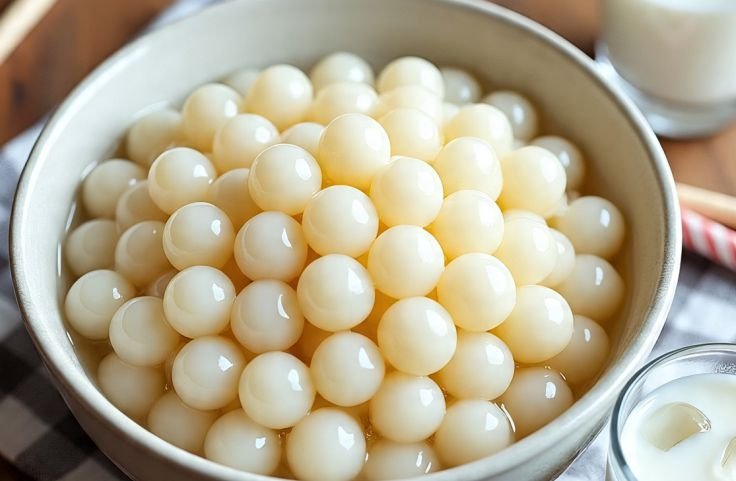Pearls made from tapioca, known for their unique texture and versatility, are a staple ingredient in various culinary delights, particularly in bubble tea and desserts.
Large tapioca pearls have captured the attention of home cooks and café enthusiasts alike due to their chewy texture and satisfying bite.
Unlike smaller pearls, their size allows them to absorb flavors more deeply, adding richness to drinks and desserts.
These pearls require careful cooking, typically involving extended boiling and resting, to achieve the perfect balance of softness and chewiness.
Proper soaking and rinsing help remove excess starch, ensuring a clean texture and enhanced taste.
Their versatility goes beyond beverages, appearing in puddings, layered desserts, and even savory dishes, making them a favorite for both traditional and creative recipes.
In this guide, you will learn how to handle large tapioca pearls, master cooking techniques, and incorporate them into dishes that delight the palate and impress visually.
Related: How to Make Tapioca Bubble Tea
Table of Contents
- What are Large Tapioca Pearls?
- Popular Uses of Large Tapioca Pearls
- Cooking Large Tapioca Pearls
- Storage and Shelf Life
- Troubleshooting Common Problems
- Where to Buy Large Tapioca Pearls
- Health Benefits of Large Tapioca Pearls
- Creative Recipe Ideas Featuring Large Tapioca Pearls
- Conclusion
- Frequently Asked Questions
What are Large Tapioca Pearls?
Large tapioca pearls, often recognized by their distinct size and texture, are a popular ingredient in various culinary traditions, particularly in bubble tea or boba drinks.
These pearls are derived from tapioca starch, which is obtained from the cassava root.
Unlike smaller varieties of tapioca pearls, large tapioca pearls boast a diameter that typically ranges from 8mm to 12mm, making them significantly more substantial.
This size not only enhances their visual appeal but also contributes to a unique texture that is chewy and satisfying when consumed.
The process of crafting large tapioca pearls involves mixing tapioca starch with water to form a dough-like consistency, which is then shaped into balls and cooked.
The larger size of these pearls means they require a longer cooking time to achieve the ideal consistency.
Once cooked, they develop a soft exterior with a chewy core, creating a delightful contrast in every bite.
This distinctive texture is one of the primary factors that sets large tapioca pearls apart from their smaller counterparts, which tend to be firmer and less chewy.
In addition to their culinary uses, large tapioca pearls are often celebrated for their versatility.
They can be used not only in beverages, particularly bubble teas, but also in desserts, such as puddings and parfaits.
The pearls can absorb flavors from their surrounding ingredients, enhancing the overall taste profile of the dish.
Furthermore, their visually striking appearance makes them an attractive topping, adding both texture and aesthetic value to a variety of recipes.
Large tapioca pearls serve as a distinctive and enjoyable element in food preparation, inviting both experimentation and innovation in their use across different cuisines.
Related Posts
Tasty Tapioca Pearls Recipes to Try
Are Tapioca Pearls Gluten Free?
How to Choose The Best Tapioca Pearls for Pudding
Popular Uses of Large Tapioca Pearls
You may notice large tapioca pearls popping up in drinks and desserts, and their chewy texture makes them irresistible.
These pearls add more than just flavor; they change how you experience a dish or beverage, giving you a playful and satisfying bite each time.
Bubble Tea: Chewy Delight in Every Sip
When you pick up a cup of bubble tea, the chewy tapioca pearls create a fun contrast with the sweet tea and milk.
You will enjoy how the pearls absorb flavors, adding depth to every sip.
Their size also makes the drink visually appealing, making it more enjoyable and Instagram-ready.
For you, each pearl adds a playful texture that makes bubble tea unforgettable.
Asian Desserts: Sweet and Creamy Indulgence
If you try Thai tapioca pearls pudding or Taiwanese shaved ice, large pearls enhance the dessert with chewy bursts in every bite.
You can feel the coconut milk or flavored syrup soaking into the pearls, creating a rich taste and smooth texture combination.
Their size makes them a standout ingredient, ensuring that every spoonful is satisfying and enjoyable for your palate.
Innovative Culinary Creations: Flavor Absorption and Texture
When you experiment with recipes, large tapioca pearls absorb flavors better than smaller ones, allowing you to create layered desserts or beverages with depth.
You can pair them with fruit, syrups, or custards, giving your creations a unique twist.
For you, their chewy texture adds an interactive element, turning ordinary recipes into memorable experiences that delight both visually and in taste.
Related: The Key Tapioca Pudding Ingredients
Cooking Large Tapioca Pearls
You will notice that cooking large tapioca pearls requires more attention than smaller ones.
Getting the right chewy texture means paying close attention to soaking, boiling times, and stirring.
With the right method, your pearls will be soft, translucent, and perfectly chewy, making your drinks or desserts stand out.
Preparing and Soaking Pearls: The First Step
Before you start cooking, rinse your large tapioca pearls under cold water to remove excess starch.
This prevents clumping while you cook. Then, soak the pearls in water for about 30 minutes.
This gives them a head start in hydration, so when you boil them, they cook evenly and maintain a satisfying chew.
Boiling and Simmering: Achieving Perfect Texture
Once soaked, place the pearls in a pot with plenty of water.
Bring it to a rolling boil over medium heat, stirring occasionally so they do not stick.
Then reduce the heat, cover the pot, and let them simmer for 30 to 45 minutes.
Check the pearls regularly; they should turn translucent while keeping a gentle firmness to the bite.
Finishing Touches: Rinsing and Preventing Clumps
After cooking, drain the pearls and rinse them under cold water to stop further cooking.
To keep them from sticking together, toss them lightly with a small amount of oil or honey.
By following these steps, you ensure that each pearl is tender, chewy, and ready to enhance your beverages or desserts with that perfect texture.
Storage and Shelf Life
You want your large tapioca pearls to stay fresh and maintain their chewy texture.
Proper storage makes all the difference in keeping them ready for your drinks or desserts anytime.
Storing Uncooked Pearls: Keep Them Dry and Cool
To maintain quality, store uncooked large tapioca pearls in a dry, airtight container.
Moisture can make them clump or spoil, affecting taste and texture.
Place the container in a cool, dark spot, like a pantry shelf or kitchen cabinet, away from sunlight.
Check them occasionally for any signs of spoilage, such as mold or unusual odor.
With proper care, they can last several months, but for the best results, use them within a year.
Storing Cooked Pearls: Timing and Temperature Matter
Once cooked, your pearls have a shorter shelf life. They stay fresh at room temperature for about 24 hours.
If you refrigerate them, they can last up to three days, though the texture may firm up.
To enjoy them later, reheat by dipping in boiling water for 30 seconds to a minute.
Maximizing Enjoyment After Storage
Even after refrigeration, you can still use cooked pearls in beverages or desserts.
Let them soak in flavors and moisture, which softens them and enhances taste.
Following these steps ensures your large tapioca pearls remain a delightful addition to your recipes every time.
Troubleshooting Common Problems
Cooking large tapioca pearls can be tricky, but knowing what to watch for helps you get the perfect chewy texture every time.
Small adjustments can make a big difference in your results.
Hard Pearls in the Center: Adjust Soaking and Boiling
If your pearls stay hard inside, the boiling time may be too short or the heat too high.
Follow package instructions for soaking and cooking, and lower the heat near the end to ensure even cooking.
Checking the pearls regularly helps you catch them at the right texture, so they turn soft and chewy throughout.
Mushy Pearls: Avoid Overcooking
Pearls that fall apart often result from overcooking. Keep an eye on the pot and test the pearls frequently.
They should remain chewy while holding their shape.
Once overcooked, there is no way to reverse the texture, so careful timing is key for consistently satisfying results.
Sticky Pearls: Rinse and Separate
If pearls stick together, it can ruin the mouthfeel. Cook them in plenty of water and rinse with cold water afterward.
Tossing the pearls lightly in coconut oil or a neutral oil helps keep them separate while adding a subtle shine.
Consistent Success: Apply Simple Techniques
Understanding these common issues allows you to troubleshoot quickly and enjoy large tapioca pearls in drinks, desserts, and other dishes.
With practice, you’ll consistently get the chewy, flavorful results you want every time.
Where to Buy Large Tapioca Pearls
Finding large tapioca pearls opens up more possibilities for your drinks and desserts.
Knowing where to shop ensures you get fresh, high-quality pearls that make your recipes shine.
Asian Grocery Stores: Reliable In-Person Options
Visiting an Asian grocery store gives you direct access to a variety of large tapioca pearls.
You can check the packaging for freshness, inspect the pearls, and choose from multiple brands.
Look for well-sealed packages and clear expiration dates to ensure quality.
Shopping in person also allows you to ask store staff for tips or brand recommendations, making your selection easier and more informed.
Online Specialty Retailers: Convenience and Variety
Shopping online gives you access to a wide selection of tapioca pearls from specialty retailers.
You can read reviews, compare brands, and check detailed product descriptions before buying.
Look for retailers with high ratings and customer feedback, as this can help you find pearls that cook well and maintain a chewy texture in your recipes.
Quality Factors: Choosing the Best Pearls
When selecting large tapioca pearls, focus on appearance and consistency.
Pearls should be opaque, uniform in size, and free from cracks.
You can also explore flavored or colored options to add creativity to your recipes.
Certifications or quality assurances give extra confidence in your purchase and help you pick pearls that perform reliably in cooking and beverages.
Making the Right Choice
Whether you shop in person or online, being aware of quality indicators and brand reputation helps you find large tapioca pearls that enhance every dish.
With the right selection, your bubble tea, puddings, and desserts will stand out for their texture and flavor.
Health Benefits of Large Tapioca Pearls
Large tapioca pearls can be a delightful addition to your diet when enjoyed in moderation.
They are naturally gluten-free, making them a suitable choice if you have gluten sensitivities or celiac disease.
These pearls are primarily carbohydrates, offering a quick source of energy, which is useful for athletes or anyone needing a gentle energy boost.
Their chewy texture also makes them satisfying without adding excessive calories, usually ranging from 100 to 200 per serving, depending on preparation.
Tapioca pearls are easy to digest, making them gentle on the stomach and suitable for sensitive digestive systems or recovery diets.
While they are not rich in vitamins or minerals, you can pair them with fruits, dairy, or fortified drinks to boost nutritional value and enjoy a flavorful, energy-supporting treat.
Creative Recipe Ideas Featuring Large Tapioca Pearls
Large tapioca pearls can bring excitement to your cooking. Their chewy texture and ability to absorb flavors make them perfect for beverages, desserts, and even savory dishes.
Here are some ways you can use them to create delightful meals that will impress both family and friends.
Bubble Tea Variations: Matcha and Fruit Infusions
You can transform a simple bubble tea into a refreshing treat by adding your favorite flavors.
Try matcha powder with creamy milk for an earthy taste, or mix in fruit purees like mango or strawberry to add color and vibrancy.
The chewy pearls create a playful texture in every sip, making each drink feel special and fun to enjoy at home.
Tropical Desserts: Mango Coconut Tapioca Pudding
Bring a tropical twist to your desserts by combining large tapioca pearls with coconut milk and mango puree.
Simmer the pearls until soft, then layer with mango for a creamy, sweet pudding.
The contrasting textures of soft pearls and smooth puree create an enjoyable bite, perfect for entertaining guests or making an everyday dessert feel indulgent.
Savory Dishes: Thai-Inspired Salads
Large tapioca pearls can add a unique touch to your savory dishes.
Toss cooked pearls with crisp vegetables, cabbage, carrots, and peanuts, then drizzle with a tangy sesame dressing.
The pearls add chewiness that balances crunchy vegetables, giving your salad a new texture dimension and surprising flavor combination.
This creative approach makes ordinary salads more interesting and fun to serve.
Conclusion
Large tapioca pearls offer a unique texture and flavor-absorbing quality that makes them stand out in your cooking.
While bubble tea introduced many to its charm, you can now use it in desserts, savory dishes, and even soups or sauces.
Their versatility allows you to experiment with different flavors and techniques, turning ordinary recipes into memorable culinary experiences.
When you cook with large tapioca pearls, try layering them in puddings, stirring them into custards, or adding them to stews for chewiness and depth.
Embracing these pearls invites creativity into your kitchen, giving every dish a playful twist.
Incorporate them into your meals and enjoy the delightful texture and taste they bring to your table.
Frequently Asked Questions
What Are Large Tapioca Pearls Made From?
Large tapioca pearls are made from tapioca starch extracted from the cassava root, providing a chewy texture that absorbs flavors in beverages and desserts.
How Do You Cook Large Tapioca Pearls Properly?
Rinse and soak the pearls first, then boil for 30 to 45 minutes, stirring occasionally, until translucent and chewy for the perfect texture.
How Should You Store Large Tapioca Pearls?
Store uncooked pearls in a dry, airtight container in a cool, dark place. Cooked pearls last 24 hours at room temperature or three days refrigerated.
Can Large Tapioca Pearls Be Used in Savory Dishes?
Yes, they can be incorporated into salads, soups, or savory Asian dishes, adding a chewy texture and absorbing flavors from dressings and sauces.
References
- Large Pearl Tapioca Pudding (AKa Eyeball Pudding) Recipe
- Large Tapioca Pearls
- Giant Pearl Tapioca Pudding

Chimeremeze Emeh is a writer and researcher passionate about Africa’s most transformative root crop—cassava. Through his work at cassavavaluechain.com, he explores the entire cassava industry, from cultivation and processing to its diverse applications in food, health, and industrial use.
He also writes for palmoilpalm.com, where he shares his extensive experience and deep-rooted knowledge of palm oil, covering red palm oil, palm kernel oil, and refined products. His work there reflects his lifelong connection to agriculture and his commitment to promoting sustainable value chains in Africa.
Driven by curiosity and purpose, Chimeremeze aims to shed light on how cassava continues to empower communities, strengthen food systems, and link traditional farming wisdom with modern innovation.

